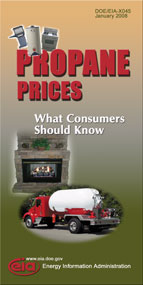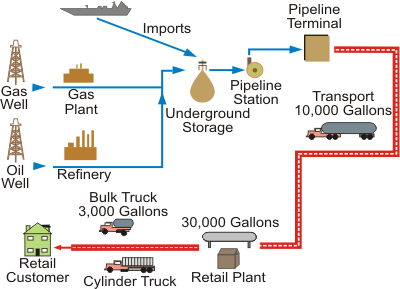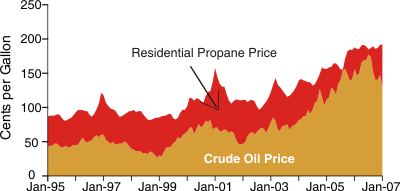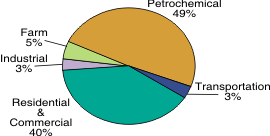|
Energy Information Administration Brochures |
|||||||||
|---|---|---|---|---|---|---|---|---|---|
Brochure #:DOE/EIA-X045
Propane Prices
What Is Propane? Most people know propane as the fuel in a white container attached to a barbecue grill. But propane has long proven its versatility for heating homes, heating water, cooking, drying clothes, fueling gas fireplaces, and as an alternative fuel for vehicles. However, more propane is used to make petrochemicals which are the building blocks for plastics, alcohol, fibers, and cosmetics, to name just a few. Propane naturally occurs as a gas at atmospheric pressure but can be liquefied if subjected to moderately increased pressure. It is stored and transported in its compressed liquid form, but by opening a valve to release propane from a pressurized storage container, it is vaporized into a gas for use. Simply stated, propane is always a liquid until it is used. Although propane is non-toxic and odorless, an identifying odor is added so the gas can be readily detected. Where Does Propane Come From? A unique feature of propane is that it is not produced for its own sake, but is a by-product of two other processes, natural gas processing and petroleum refining. Figure 1 shows a diagram of where propane comes from and how it gets to the consumer. Natural gas plant production of propane primarily involves extracting materials such as propane and butane from natural gas to prevent these liquids from condensing and causing operational problems in natural gas pipelines. Similarly, when oil refineries make major products such as motor gasoline and heating oil, some propane is produced as a by-product of those processes. It is important to understand that the by-product nature of propane production means that the volume made available from natural gas processing and oil refining cannot be adjusted when prices and/or demand for propane fluctuate. In addition to these two processes, demand is met by imports of propane and by using stored inventories. Although imports provide the smallest (about 10 percent) component of U.S. propane supply, they are vital when consumption exceeds available domestic supplies of propane. Propane is imported by land (via pipeline and rail car from Canada) and by sea (in tankers from such countries as Algeria, Saudi Arabia, Nigeria, and Norway). Figure 1. Propane Production and Distribution System
What Influences Propane Prices? Propane prices are subject to a number of influences, some common to all petroleum products, and others unique to propane. Because propane is portable, it can serve many different markets, from fueling barbecue grills to producing petrochemicals. The price of propane in these markets is influenced by many factors, including the prices of competing fuels in each market; the distance propane has to travel to reach a customer; and the volumes used by a customer. More especically, propane prices are affected by: Crude Oil and Natural Gas Prices – Although propane is produced from both crude oil refining and natural gas processing, its price is influenced mainly by the cost of crude oil. This is because propane competes mostly with crude oil-based fuels (Figure 2). Figure 2. Propane Prices Follow Crude Oil Price Trends Note: Data are not adjusted for inflation. Supply/Demand Balance – Propane supply and demand is subject to changes in domestic production, weather, and inventory levels, among other factors. While propane production is not seasonal, residential demand is highly seasonal. This imbalance causes inventories to be built up during the summer months when consumption is low and for inventories to be drawn down during the winter months when consumption is much higher. When inventories of propane at the start of the winter heating season are low, chances increase that higher propane prices may occur during the winter season. Colder-than-normal weather can put extra pressure on propane prices during the high demand winter season because there are no readily available sources of increased supply except for imports. And imports may take several weeks to arrive, during which time larger-than-normal withdrawals from inventories may occur, sending prices upward. Cold weather early in the heating season can cause higher prices sooner rather than later, since early inventory withdrawals affect supply availability for the rest of the winter. Proximity of Supply – Due to transportation costs, customers farthest from the major supply sources (the Gulf Coast and the Midwest) will generally pay higher prices for propane. Markets Served – Propane demand comes from several different markets that exhibit distinct patterns in response to the seasons and other influences. Residential demand, for instance, depends on the weather, so prices tend to rise in the winter. The petrochemical sector is more flexible in its need for propane and tends to buy it during the spring and summer, when prices decline. If producers of petrochemicals should have to depart from this pattern for some reason, the coinciding demand could raise prices. And when prices rise unexpectedly, as they do sometimes in the winter, petrochemical producers pull back, helping to ease prices. Prices could also be driven up if agricultural sector demand for propane to dry crops remains high late into the fall, when residential demand begins to rise. Different markets also use different volumes of propane which impact the price. For example, the petrochemical sector, which is primarily located near major propane supply sources, uses large volumes of propane that are delivered by pipeline. This allows for a lower unit cost (cents per gallon) for the propane compared to other propane consumers. However, residential consumers use relatively small volumes of propane that are delivered long distances by interstate pipeline and by truck which causes the unit price for propane to be much higher.
Why Do Propane Prices Spike? Propane prices occasionally spike, increasing disproportionately beyond that expected from normal supply/demand uctuations. The main cause appears to lie in the logistical difficulty of obtaining resupply during the peak heating season. Because propane is produced at a relatively steady rate year-round by refineries and gas processing plants, there is no ready source of incremental production when supplies run low. Propane wholesalers and retailers are forced to pay higher prices as propane markets are bid higher due to dwindling supply. Consequently, higher propane prices are simply passed on to consumers. Imports do not offer much cushion for unexpected demand increases or supply shortages due to the long travel time. On the other hand, when propane prices do spike, the petrochemical sector may cut back on its use, thus freeing up supplies for other uses. For current information on propane prices, supply, and demand, see the “Heating Oil and Propane Update” section of the Energy Information Administration’s (EIA) web site at:
|
|||||||||



